This is from an email I wrote a group of friends last year. We had an email book club, and this was my take on The Da Vinci Code. This won't make that much sense if you haven't actually read the book.
I totally enjoyed the book, but I thought a lot of the guy's "research" was one-sided, funneled only to uphold his argument and a lot of it his logic had big holes. His argument about Disney being a Priory member was a good example of the leaps he makes that don't always connect. When you actually know something about it, it doesn't quite hold up. "The Little Mermaid's name, Ariel, possess powerful ties to the sacred feminine, and in the Book of Isaiah, was synonymous with 'the Holy City besieged.' Of course, the Little Mermaid's flowing red hair was no coincidence either." Oh, of course! It's obvious, now.
I thought one of the most ridiculous scenes in the book was when they were looking at The Last Supper. They almost seemed to think they were looking at a photograph of the actual event instead of a painting done almost 1500 years after the fact. If you look at John the Beloved sitting next to Jesus (or, Mary, if you buy the theory), you'll see he does look very feminine.
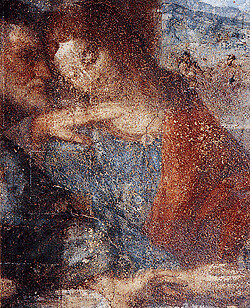
The Last Supper, John the Beloved, detail
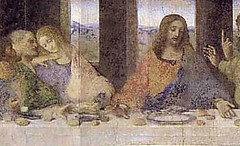
The Last Supper, John the Beloved and Christ, detail
However, you have to realize that this is John the Beloved, the youngest of the apostles. He is traditionally shown more feminized. Christ's face looks somewhat feminine as well.
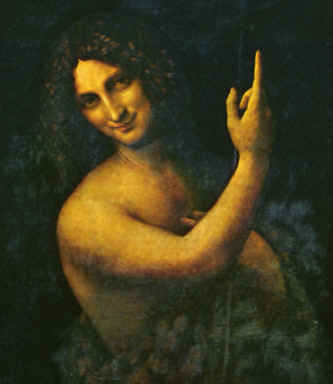
John the Baptist
If you compare it to a painting the DaVinci did of John the Baptist, you'll see it's almost the same face. And the second picture is obviously a man. In Albrecht Durer's engraving of the Last Supper, John has fallen into the arms of Jesus. From a modern perspective, it looks a little strange, but it doesn't make John Mary.
Another thing to know about DaVinci's Last Supper is that it depicts the moment that Jesus has just announced that someone will betray him. This would explain why Peter is looking menacingly at John. The hand and knife is right in front of Judas (the guy on the left with both of his hands up looking like 'I didn't do it"). I think this has a lot more to do with Judas' betrayal of Jesus than the church's betrayal of Mary Magdalene. Plus, the hand is not disembodied - both a preliminary drawing by Leonardo and early copies of "The Last Supper" show that the hand and dagger belong to Peter - a reference to Peter drawing a sword in defense of Jesus.

The Last Supper (click to embiggen)
The fact that Jesus and John form a V was obviously done on purpose (I don't quite see the M), but to say that that negative space represents the sacred feminine and the chalice is reaching. It could be (because it could be anything), but it seems more likely that it is an optical trick, to draw your eye to the center of the painting. To me, the fact that there were 13 cups is not strange at all. It's only strange if your whole focus is on a fancy Holy Grail.
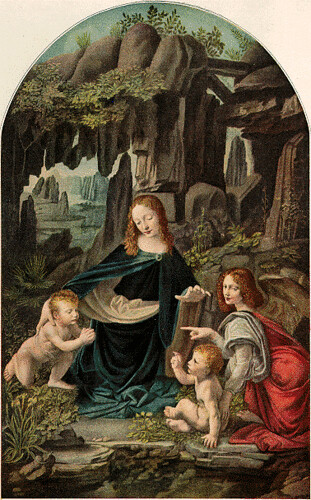
Madonna of the Rocks
His description of the Madonna of the Rocks was also inaccurate. I looked at both versions and, to me, Mary's hand does not look like eagle talons and the angel's hand appears to simply be pointing at John, not slicing off a head. Also, when he says that Jesus is "presumably" the child next to Mary, he is not. Anytime you have a baby with his fingers up in blessing, that is "presumably" Jesus. Also, anyone who has read the New Testament knows that John the Baptist is older than Jesus. The child kneeling looks older than Jesus.
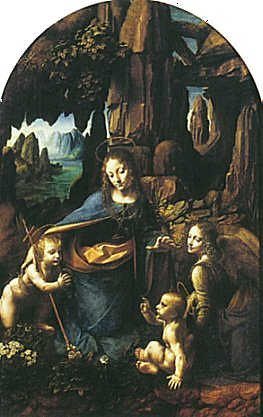
Madonna of the Rocks, second version
The second painting has the same set up, it just adds halos and the angel is no longer pointing to John.
The assertions that Christ's divinity was simply voted on at the Nicaean council and wasn't a part of Christianity before Constantine is ridiculous. The idea that the Catholic church was trying to eradicate the sacred feminine is ludicrous. This is a church that prays to Mary and had the cult of St. Anne (Mary's mother). The sacred feminine is deeply entrenched - just not in a pagan sense. This is a very modern idea that if our god was a woman we would respect women more. I have a tough time believing that tribal, pagan communities that worshipped goddesses (and gods) were so progressive. These are the same people who sacrificed young virgins. Although, the word pagan is actually a Christian term for anyone who is not Christian, so you're talking about a wide variety of religions.
I read an interesting book called The Gift of the Jews and it asserts that western culture has evolved as it has and is great because we moved away from the goddess culture and earth religions. Judaism gave us the concept of the individual, the idea that you can create your destiny and basically laid the foundation for ideas like democracy and justice. Anyway, to get into that book is probably too off the mark, but it was interesting for me to have read that in light of this book.
I liked how fast paced the book was. In the end, things got a little predictable and tied up a little too neatly, but overall it was a fun read.

 The DaVinci Code
The DaVinci Code













































